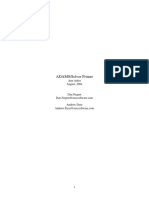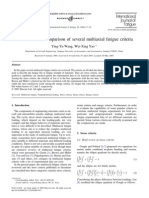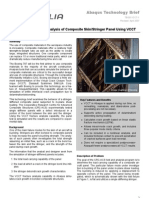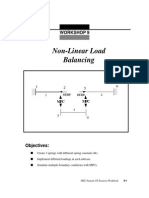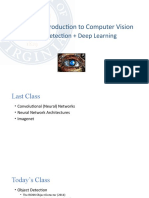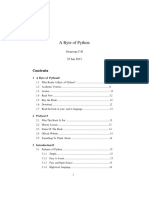Neuber Method For Fatigue
Neuber Method For Fatigue
Uploaded by
Kuan Tek SeangCopyright:
Available Formats
Neuber Method For Fatigue
Neuber Method For Fatigue
Uploaded by
Kuan Tek SeangOriginal Title
Copyright
Available Formats
Share this document
Did you find this document useful?
Is this content inappropriate?
Copyright:
Available Formats
Neuber Method For Fatigue
Neuber Method For Fatigue
Uploaded by
Kuan Tek SeangCopyright:
Available Formats
ENGINEERING STRUCTURAL INTEGRITY ASSESSMENT
APPLICATION OF THE NEUBER APPROACH TO PREDICT CRACK
INITIATION IN COMPONENTS
C. M. Davies*, N. P. ODowd*, K. M. Nikbin*, F. Biglari, G. A. Webster*
The Neuber method is commonly used to estimate the stress field ahead of
a crack tip in an elastic-plastic material and has been incorporated into a
number of failure assessment procedures. In this work a compact tension
specimen is examined under plane strain conditions using the
Ramberg-Osgood power law plasticity model. It is found that existing
procedures provide a reasonable estimate of the equivalent von Mises
stress over a wide range of load levels, but non-conservative estimates of
the maximum principal stress. A method is proposed to determine the
maximum principal stress from the equivalent stress determined by the
Neuber method. Through the use of the proposed techniques, accurate
estimates of the von Mises equivalent and maximum principal stress
ahead of a sharp crack tip can be obtained. The implications of the result
in terms of the lifetime prediction of cracked components are discussed.
INTRODUCTION
In component lifetime assessments a procedure, known as the sigma-d method, has
been proposed to estimate the crack initiation period from pre-existing defects, i.e. the
time required for the onset of crack growth due to creep and/or fatigue. The method,
developed by Moulin et al. [1], predicts that initiation occurs under creep conditions
when the stress at a distance d ahead of the crack tip is equal to the stress which causes
rupture under uniaxial conditions.
The sigma-d method has recently been introduced into the British Energy defect
assessment procedure, R5 [2]. The method is currently based on the elastic-plastic
stress field generated ahead of the crack tip and does not consider the relaxation of
stress due to creep. This stress field may be estimated by a number of methods
including procedures based on Neubers rule [3].
In Davies et al. [4] a comparison of the crack tip stress field predictions obtained
from a number of methods, including Neubers method, with full field finite element
solutions has been performed, for a CT specimen under plane strain conditions. Some
of the key results of [4] are reviewed here. In addition, the sensitivity of the sigma-d
*Department of Mechanical Engineering, Imperial College London, South Kensington Campus, London SW7 2AZ.
Department of Mechanical Engineering, Amirbkabir University of Technology, Hefez Avenue, Tehran, Iran
Contact author email address: catrin.davies@imperial.ac.uk
EMAS 2004
ENGINEERING STRUCTURAL INTEGRITY ASSESSMENT
method, and hence lifetime predictions, to the stress estimate will be considered.
STRESS ESTIMATES FROM NEUBERS METHOD
Neuber [3] proposed that, for a material which obeys a non-linear deformation law that
is linear at vanishingly small stresses, the maximum stress in the vicinity of a sharply
curved notch is related to the nominal (remote) stress through a linear elastic stress
concentration factor. Neuber [3] suggests that the method may be generalised to any
arbitrary loading state through the use of the equivalent stress.
Different interpretations of the Neuber method are found in the literature, which
predict either the stress normal to the crack plane (which is also the maximum principal
stress in the plane of the crack under Mode I conditions) or the equivalent von Mises
stress. A brief description of four Neuber methods detailed in [4] follows and a
summary of the key equations are given in Table 1.
TABLE 1
Method
Name
Neuber
Summary of Neuber methods
Stress
Predicted
Equation
N
N
Equivalent,
0 d
de 0 ref (1)
d
de
+
=
+
d
de
d
E
E ref
E 0
E 0
Max.
Neuber-R5 Principal,
d
Neuber- Equivalent,
R5(A)
d
Max.
Neuber(M) Principal,
(2)
0 d
ref
de
+ 0
= de
E
E 0
E 0
(3)
d d
0 d
ref
de
+ 0
= de
E
E 0
E 0
N
M ME
N
N
0 d
0 ref (4)
de
=
+
de
E
E M 0
E 0
The derivation of Eqs. (1)(4), shown in Table 1, is given in [4]. In Table 1
d and
d refer to, respectively, the equivalent von Mises stress and the maximum principal
stress in the plane of the crack (or stress normal to the crack plane) at a distance d
ahead of the crack tip. Likewise,
de and de refer to the equivalent von Mises linear
elastic stress and the maximum principal linear elastic stress in the plane of the crack, at
a distance d ahead of the crack tip. All the equations in Table 1 contain terms of the
EMAS 2004
ENGINEERING STRUCTURAL INTEGRITY ASSESSMENT
form stress strain. In the equations the stress-strain relation is described by a
Ramberg-Osgood type equation where N is the strain hardening power law dependence,
E is the Youngs Modulus, 0 is the normalising stress and is a constant. The
definition of equivalent strain used in Eqs. (1) and (3) is based on the relationship
proposed in Harkegaard and Mann [6] where the total equivalent strain is given by the
sum of the von Mises elastic and plastic deviatoric strains, giving rise to an effective
elastic modulus E = 3E (2(1 + v)) where is the Poissons ratio. An alternative
definition of equivalent strain (see e.g. Chen et al. [7]) may be used, in which case
E = E. Also in Eqs (1)(4) the nominal stress is taken to be the reference stress, ref
(see e.g. Webster and Ainsworth [5]).
For a sharp crack the linear elastic equivalent (von Mises) stress in the crack plane
de, is determined from the K field,
at a distance d directly ahead of the crack tip,
de =
K
where
2 d
1 2v for plane strain
1
for plane stress.
(5)
In Eq. (5) K is the linear elastic stress intensity factor. Similarly the linear elastic
maximum principal stress at d, de, is given by
de =
K
2 d
(6)
under both plane stress and plane strain conditions.
The equivalent (von Mises) elastic-plastic stress at a distance d ahead of the crack
tip, d , may be obtained by the solution of the Neuber method (Eq. 1). In the R5
sigma-d procedure, the maximum principal elastic-plastic stress at a distance d directly
ahead of the crack tip, d, is given by the solution of Eq. (2), here denoted the
Neuber-R5 method. (A value of d equal to 50 m is recommended in the R5 procedure
for austenitic stainless steels).
An alternative form of the R5 equation is proposed in [4] to predict the equivalent
stress by replacing the maximum principal stresses d and de in Eq. (2) by their
equivalent stress values, d and
de, respectively. The resultant equation, Eq. (3) in
Table 1, is denoted the adapted R5 equation or the Neuber-R5(A) method and differs
from Eq. (1) since the second term in the bracket on the right hand side (the equivalent
plastic strain at reference stress) is not amplified by the linear elastic stress
de/ref). Hence the Neuber-R5(A) method does not precisely
concentration factor (
follow the original formulation of Neuber given by Eq. (1).
In the defect assessment procedures R5 [3] and A16 [8] the maximum principal
stress (stress normal to the crack plane), d, is used to predict the time to crack
initiation. An alternative approach to determining d has been proposed in [4]. There d
was obtained by scaling the corresponding equivalent stress, d , obtained from the
EMAS 2004
ENGINEERING STRUCTURAL INTEGRITY ASSESSMENT
Neuber method. For a given d the value of the ratio d /d is dependent on load,
specimen geometry and strain hardening power law dependence, N. Based on finite
element studies on a CT specimen a representative value of d /d , denoted M, has been
used to determine d from the equivalent Mises stress obtained from the Neuber-R5(A)
method. The value of M has the following dependency on load [4]
M=
ref
d
= 0.22
+ 2.96 .
d
0
(7)
The function M shown in Eq. (7) has been chosen to be conservative over the relevant
crack tip distances, for N between 5 and 10, and to give optimal agreement with the FE
solutions at d = 50 m. The maximum principal stress, d, may be estimated by solving
Eq. (4) using the M value calculated from Eq. (7).
ANALYSIS METHODS AND MODELS
Specimen Geometry, Material and Finite Element Model
A compact tension (CT) specimen has been examined with a crack length to specimen
width ratio, a/W, equal to 0.5. The Ramberg-Osgood material model is used with
= 0.1, E/0 = 912, representative of austenitic stainless steel at around 600oC. Two
values of N have been used, N = 5 and 10. Plane strain conditions have been examined
and small displacement theory used (i.e. effects of crack blunting have been ignored).
Finite element calculations have been performed using the commercial software
package ABAQUS [9]. Only one half of each specimen has been modelled due to
symmetry and a sharp crack has been represented with a focused mesh at the crack tip.
The mesh for the CT specimen consists of 2005 nodes and 1895 plane strain, linear
hybrid elements. Further details of the finite element analysis are provided in [4].
Stress Estimates and Initiation Time Predictions
The four Neuber equations, shown in Table 1, have been solved iteratively to give the
stress d or d . The accuracy of the Neuber stress estimates has been assessed by
comparison with finite element solutions. The sensitivity of the initiation time
predictions given by sigma-d method to the accuracy of the various stress estimates has
also been examined. The sensitivity is assessed by calculating the ratio between the
initiation time predicted from the Neuber stress estimate to that obtained from the finite
element stress solution. For this purpose, a stress to rupture time relation has been
assumed such that the initiation time, ti, is estimated from (see e.g. [5])
ti = B p .
EMAS 2004
(8)
ENGINEERING STRUCTURAL INTEGRITY ASSESSMENT
where p and B are the rupture stress exponent and constant, respectively and is the
relevant stress estimate (i.e. d or d ). A typical value of p equal to 10 has been
assumed. The results are expressed here in normalised form and are independent of B.
RESULTS
Maximum Principal Stress PredictionsNeuber-R5 Method
A comparison of the maximum principal stress distributions, d, over a range of crack
tip distances d, obtained from the Neuber-R5 method (Eq. 2) and the finite element
(FE) results is presented in Fig. 1 for N = 10. All stress values are normalised by 0 and
the distance, d, is normalised by crack length, a. The results for ref /0 = 0.1 and 1.8
are shown in Fig. 1(a) and (b), which correspond to small scale and large scale yielding
conditions, respectively. At ref /0 = 0.1 the stress predicted by the Neuber-R5 method
falls below the FE solution at d/a < 0.004. Very poor agreement between the
Neuber-R5 estimate and FE solution is seen in Fig. 1(b) for ref /0 = 1.8.
Based on a standard CT specimen (W = 50 mm), the ratio between the d stress
from the Neuber-R5 method and the FE solution at d = 50 m is shown in Fig. 2(a) for
N = 5 and 10 (A distance d = 50 m corresponds to d/a = 0.002 for a standard CT
specimen). The Neuber stress estimate and the finite element solution are represented in
the figure by the subscripts N and FE, respectively. It is seen in Fig 2(a) that a
non-conservative prediction of d (indicated by a stress ratio less than 1) is obtained by
the Neuber-R5 method over the entire load range. The ratio of the respective initiation
time predictions from Eq. (8) is shown in Fig. 2(b). It is seen that the values of
initiation time, ti, predicted from the Neuber-R5 stress estimate for ref /0 > 0.2 are
non-conservative and up to four orders of magnitude greater than the predictions based
on the FE stress solution. Note that the implicit assumption here is that initiation is
controlled by the maximum principal stress and hence in Eq. (8) is equal to d.
Equivalent von Mises Stress PredictionsNeuber and Neuber-R5(A)
A comparison of the d stress from the Neuber method, Eq. (1), the Neuber-R5(A)
method, Eq. (3), and the FE solution is presented in Fig. 3 for N = 10. For ref /0 = 0.1
(Fig. 3a) the solutions are almost indistinguishable from each other. At ref /0 = 1.8
(Fig. 3b) it can be seen that both methods provide a conservative prediction of the
equivalent von Mises stress distribution, relative to the FE distribution, over the
distances of interest.
In Fig. 4(a), the ratios between the d stress from the Neuber and Neuber-R5(A)
methods and the FE solution are shown over the load range considered, for d = 50 m
(based on a standard CT specimen). For ref /0 < 1.0 results from both solutions are
virtually indistinguishable, and are slightly non-conservative for ref /0 < 0.2. At
higher loads a conservative prediction is achieved by both methods. It is also seen in
EMAS 2004
ENGINEERING STRUCTURAL INTEGRITY ASSESSMENT
the figure that the prediction from the Neuber-R5(A) method (the solid line)
consistently falls below that of the Neuber method (the dash line) and is significantly
less conservative, though more accurate, at high loads (ref /0 > 0.8). Figure 4(b)
shows the ratios of the predicted initiation times, assuming that initiation is controlled
by the equivalent stress. It is seen that the Neuber stress estimate (Eq. 1), in conjunction
with Eq. (8), leads to a prediction of ti that is more conservative than that from the
Neuber-R5(A) stress estimate and is in fact on the order of four times more
conservative for N = 10 at high loads.
Maximum Principal Stress Predictions Modified Neuber Method
A comparison of the d stress determined by the modified Neuber method (Neuber(M))
is shown in Fig. 5 for the CT specimen with N = 10. At ref /0 = 0.1 (Fig. 5a), the
Neuber(M) stress estimate is almost indistinguishable from the FE solution. At the
higher load of ref /0 = 1.8 (Fig. 5b) the scaling factor used provides conservative
results for d/a > 0.002. In this region the Neuber(M) stress is approximately 20%
higher than the finite element solution.
The ratio between the maximum principal stress in the plane of the crack, d,
estimated by the modified Neuber method and that obtained from the FE solution is
shown in Fig. 6(a) for N = 5 and 10. Results are in all cases conservative, indicated by a
ratio greater than 1. Consequently, conservative initiation time predictions are obtained
by the Neuber(M) stress estimate in relation to the FE solution, indicated by a ratio less
than 1 in Fig. 6(b). It is seen in this figure that initiation time predictions from
Neuber(M) are very close to those predicted from the FE stress at intermediate loads,
and within an order of magnitude of the FE prediction over the load range.
Comparison of Neuber R5 Maximum Principal Stress Estimates to the FE von Mises
Stress Solution
The ratio between the maximum principal stress estimate at d = 50 m from the
Neuber-R5 method, (d)N , and the FE solution for the equivalent Mises stress, (d )FE
is shown in Fig. 7(a). If it is assumed that initiation time is controlled by the equivalent
d, as in e.g. [5], and not by the maximum principal stress, d, as proposed in the
stress
sigma-d method, Fig. 7(a) indicates that the use of the Neuber- R5 method (giving d)
will provide a conservative prediction for the cases considered, under plane strain
conditions. Within the load range (0.2 ref /0 1.4) for N = 10, the ratio
(d )N / (d )FE is generally constant at around 1.3 (see Fig. 7a). Therefore using Eq. (8)
and assuming that crack initiation under creep conditions is controlled by the equivalent
stress; the resultant ti predicted from the Neuber-R5 method would be conservative
(underpredict the initiation time) by a factor of around fourteen for this load range,
under plane strain conditions, as shown in Fig 7(b) (i.e. considerably more conservative
than the Neuber(M) method).
EMAS 2004
ENGINEERING STRUCTURAL INTEGRITY ASSESSMENT
DISCUSSION AND CONCLUSIONS
Crack tip stress distributions have been predicted by the Neuber method and the full
field solution has been obtained from finite element calculations on a CT specimen.
Under plane strain conditions non-conservative predictions of the maximum principal
stress in the plane of the crack, d, over a range of distances d, have been obtained from
the Neuber method, as proposed in the current R5 procedure [2]. An adapted form of
the R5 Neuber method (Neuber-R5(A)) is proposed, which replaces the maximum
principal stress with the equivalent von Mises stress. This method provides
conservative estimates of the equivalent von Mises stress d . The method, here
designated Neuber-R5(A), used is not precisely consistent with the original form of
Neubers rule, but it is found that, under plane strain conditions and for the material
properties chosen, more accurate (though less conservative) estimates of d are
obtained using this equation than are obtained using an equation consistent with
Neubers original formulation. Encouraging results are also obtained from the
Neuber(M) method, which has been proposed to obtain an estimate of d.
The stress estimates at a distance d = 50 m ahead of the crack tip (based on a
standard CT specimen, a = 25 mm) have subsequently been used in the sigma-d method
to predict the time to crack initiation under creep conditions and compared to
predictions based on the corresponding FE stress solution. Only the Neuber(M) stress
estimate leads to conservative initiation time predictions, compared to predictions
based on the FE stress solutions, for ref /0 > 0.2. If failure is controlled by the
maximum principal stress non-conservative estimates of initiation time may be
obtained using the current versions of the R5 sigma-d procedure. However, if initiation
is controlled by the equivalent stress, conservative initiation time predictions are
expected from the procedure since the value of the Neuber-R5 stress estimate is found
to be greater than the value of the respective finite element equivalent von Mises stress.
The discussion here has been limited to the case when crack initiation is controlled
either by the maximum principal stress or the equivalent stress. However, more
generally, initiation may be controlled by some combination of the maximum principal
and equivalent stress values. For this situation conservative results are expected to be
obtained through the combined use of the Neuber-R5(A) and Neuber(M) equations.
ACKNOWLEDGEMENTS
The authors would like gratefully to acknowledge helpful discussions with Dr Manus
ODonnell of British Energy Generation Ltd.
LIST OF SYMBOLS
a, W
B, p
d
EMAS 2004
Crack length and width of specimen, respectively
Creep rupture constant and exponent, respectively
Distance directly ahead of crack tip in the plane of the crack
ENGINEERING STRUCTURAL INTEGRITY ASSESSMENT
E, E
K
, 0, N
d
de
de
ref
v
Youngs modulus, Effective elastic modulus
Linear elastic crack tip stress intensity factor
Constants in Ramberg-Osgood plasticity law
Equivalent (von Mises) stress at a distance d ahead of crack tip
Equivalent linear elastic stress at a distance d ahead of the crack tip
Stress normal to crack plane (Maximum principal stress in the crack
plane) at a distance d ahead of the crack tip
Linear elastic d stress
Reference stress
Poissons ratio
REFERENCE LIST
(1)
Moulin, D., Drubay, B., Acker, D., and Laiarinandrasana, L., A Practical Method
Based on Stress Evaluation (d Criterion) to Predict Initiation of Crack Under
Creep and Creep-Fatigue Conditions, J. Press. Vess-T ASME, 1995, Vol. 117, pp.
16.
(2)
British Energy Generation Ltd., R5: Assessment Procedure for the High
Temperature Response of Structures. BEGL., Issue 3, 2003.
(3)
Neuber, H., Theory of Stress Concentration for Shear Strained Prismatic Bodies
with Arbitrary Non-Linear Stress Strain Law. J. App. Mech-T ASME, 1961, pp.
544550.
(4)
Davies, C. M., ODowd, N. P., Nikbin, K. M., Webster, G. A., Biglari, F.,
Comparison of Methods for Obtaining Crack Tip Stress Distributions in an
Elastic-Plastic Material, Submitted for publication, 2004.
(5)
Webster, G. A. and Ainsworth, R. A., High Temperature Component Life
Assessment. 1st ed. 1994, Chapman and Hall: London.
(6)
Harkegaard, G. and Mann, T., Neuber Prediction of Elastic-Plastic Strain
Concentration in Notched Tensile Specimens Under Large-Scale Yielding. J.
Strain Anal. Eng, 2003, Vol. 38(1), pp. 7994.
(7)
Chen, G. X., Wang, C. H., and Rose, L. R. F., A Perturbation Solution for a Crack
in a Power Law Material Under Gross Yielding. Fatigue Frac. Eng. M, 2002,
Vol. 25, pp. 231242.
(8)
RCC-MR, Guide for Leak Before Break Analysis and Defect Assessment,
Appendix A16, 2002, AFCEN.
(9)
ABAQUS Users Manual, Version 6.2, Hibbit, Karlsson & Sorenson Inc., 2001.
EMAS 2004
ENGINEERING STRUCTURAL INTEGRITY ASSESSMENT
FIGURES
5.0
10.0
ref / 0 = 0.1
N = 10
4.0
ref / 0 = 1.8
3.0
2.0
1.0
4.0
2.0
0.0
0.00
(b)
0.01
0.02
0.03
0.0
0.00
0.04
0.01
d /a
0.04
1.E+05
0.7
1.E+03
N =5
0.6
N = 10
0.5
0.4
1.E+04
ti (d )N / ti (d )FE
0.8
(d )N / (d )FE
0.03
d /a
d = 50 m
a = 25 mm
0.9
N = 10
1.E+02
1.E+01
(a)
(b)
0.2
N = 5
d = 50 m
a = 25 mm
1.E+00
0.0 0.2 0.4 0.6 0.8 1.0 1.2 1.4 1.6 1.8
ref / 0
Figure 2
0.02
Comparison of normalised d stress predictions from Neuber-R5 and FE for
(a) ref /0 = 0.1 and (b) ref /0 = 1.8.
1.0
0.3
Neuber - R5
6.0
(a)
Figure 1
FE
N = 10
8.0
Neuber - R5
d /0
d /0
FE
0.0 0.2 0.4 0.6 0.8 1.0 1.2 1.4 1.6 1.8
ref / 0
Ratio between (a) d stress and (b) ti prediction from Neuber-R5 and FE.
EMAS 2004
ENGINEERING STRUCTURAL INTEGRITY ASSESSMENT
2.5
2.0
1.5
1.0
1.5
1.0
0.5
0.5
0.01
0.02
0.03
0.0
0.00
0.04
0.01
1.6
1.E+01
Neuber
Neuber - R5(A)
1.4
N =5
1.3
1.2
1.1
1.0
d = 50 m
a = 25 mm
N = 10
(a)
1.E-01
Neuber
(b)
Neuber R5(A)
0.0 0.2 0.4 0.6 0.8 1.0 1.2 1.4 1.6 1.8
ref / 0
ref / 0
Ratio between the (a) von Mises stress and (b) initiation time prediction
from the Neuber method, the adapted R5 Neuber method and FE.
10.0
ref / 0 = 0.1
ref / 0 = 1.8
Neuber (M)
N = 10
4.0
d /0
2.0
N = 10
8.0
FE
3.0
1.0
6.0
4.0
Neuber (M)
2.0
(a)
0.0
0.00
FE
(b)
0.01
0.02
0.03
0.04
d/a
Figure 5
N = 10
1.E-03
0.0 0.2 0.4 0.6 0.8 1.0 1.2 1.4 1.6 1.8
Figure 4
N = 5
1.E-02
1.E-04
0.8
5.0
0.04
d = 50 m
a = 25 mm
1.E+00
ti (d )N / ti (d )FE
1.5
0.9
0.03
Comparison of normalised d stress predictions Neuber-R5(A) and FE for
(a) ref /0 = 0.1 and (b) ref /0 = 1.8.
Figure 3
(d )N / (d )FE
0.02
d/a
d/a
d / 0
Neuber
Neuber - R5(A)
FE
N = 10
(b)
(a)
0.0
0.00
ref / 0 = 1.8
2.0
d / 0
d / 0
2.5
FE
ref / 0 = 0.1
Neuber
N = 10
Neuber - R5(A)
0.0
0.00
0.01
0.02
0.03
0.04
d/a
Comparison of normalised d stress distributions from Neuber(M) and FE
for (a) ref /0 = 0.1 and (b) ref /0 = 1.8.
EMAS 2004
10
ENGINEERING STRUCTURAL INTEGRITY ASSESSMENT
1.6
1.E+01
d = 50 m
a = 25 mm
1.E+00
(d )N / (d )FE
1.4
1.3
N = 10
1.2
N =5
1.1
1.0
ti (d )N / ti (d )FE
1.5
1.E-01
N = 10
1.E-03
0.9
0.8
1.E-04
0.0 0.2 0.4 0.6 0.8 1.0 1.2 1.4 1.6 1.8
ref / 0
0.0 0.2 0.4 0.6 0.8 1.0 1.2 1.4 1.6 1.8
ref / 0
Figure 6
2.6
Ratio between (a) d stress and (b) ti prediction from Neuber(M) and FE.
2.0
1.8
N = 10
1.6
1.4
1.2
1.E-01
1.E-02
N = 10
1.E-03
(b)
(a)
1.0
d = 50 m
a = 25 mm
1.E+00
N =5
ti (d )N / ti (d )FE
2.2
(d )N / (d )FE
1.E+01
d = 50 m
a = 25 mm
2.4
d = 50 m
a = 25 mm
(b)
(a)
N = 5
1.E-02
N = 5
1.E-04
0.0 0.2 0.4 0.6 0.8 1.0 1.2 1.4 1.6 1.8
ref / 0
Figure 7
0.0 0.2 0.4 0.6 0.8 1.0 1.2 1.4 1.6 1.8
ref / 0
Ratio between (a) d from Neuber-R5 and d from FE and (b) their
respective initiation time predictions.
EMAS 2004
11
You might also like
- Engineering AuditDocument14 pagesEngineering AuditBiplab MohantyNo ratings yet
- Marketing Plan For Edinburgh and Glasgow Physiotherapy CentreDocument43 pagesMarketing Plan For Edinburgh and Glasgow Physiotherapy CentreLoredana Bleiziffer100% (1)
- AFFDL-TR-67-140 - Design Criteria For The Prediction and Prevention of Panel Flutter - Volume I - Criteria PresentationDocument64 pagesAFFDL-TR-67-140 - Design Criteria For The Prediction and Prevention of Panel Flutter - Volume I - Criteria PresentationMB-RPNo ratings yet
- Total NAS102Document363 pagesTotal NAS102Alejandro Palacios MadridNo ratings yet
- MSC Adams Solver PDFDocument67 pagesMSC Adams Solver PDFmilind9897100% (1)
- Airbag Memories CompleteDocument201 pagesAirbag Memories Completeschraeuble40% (5)
- Buckling - EquationsDocument66 pagesBuckling - EquationsricardoborNo ratings yet
- Fem Result ValidationDocument48 pagesFem Result ValidationBrian Cruz100% (2)
- Generation of Spectra & Stress Histories For F&DT Analysis of Fuselage Repairs-BroekDocument56 pagesGeneration of Spectra & Stress Histories For F&DT Analysis of Fuselage Repairs-BroekSteve McClintock100% (1)
- Derivation of Endurance Curves From Fatigue Test Data, Including Run-OutsDocument39 pagesDerivation of Endurance Curves From Fatigue Test Data, Including Run-OutscumtjerryNo ratings yet
- TL 1.16 Material Allowable Strength DataDocument83 pagesTL 1.16 Material Allowable Strength DataMohd Hairie Yusuf100% (1)
- Failure Modes of Fibre Reinforced Laminates: 1. NotationDocument14 pagesFailure Modes of Fibre Reinforced Laminates: 1. Notationjunjie yiNo ratings yet
- Astm E1049 85 2017Document6 pagesAstm E1049 85 2017Alexandre JesusNo ratings yet
- Hyper SizerDocument16 pagesHyper SizerKamlesh Dalavadi100% (1)
- Boxes Part V7Document70 pagesBoxes Part V7davidNo ratings yet
- Ar97 2 2Document346 pagesAr97 2 2Mona AwadNo ratings yet
- VCCTDocument64 pagesVCCTAli FahemNo ratings yet
- Nafems Benchmark AerospaceDocument57 pagesNafems Benchmark Aerospacegarystevensoz0% (1)
- Evaluation and Comparison of Several Multi Axial Fatigue CriteriaDocument9 pagesEvaluation and Comparison of Several Multi Axial Fatigue CriteriaEbrahim AlvandiNo ratings yet
- Graficas Intercambiadores (NTU)Document269 pagesGraficas Intercambiadores (NTU)Junior RodriguezNo ratings yet
- Crippling Analysis of Composite Stringers PDFDocument9 pagesCrippling Analysis of Composite Stringers PDFDhimas Surya NegaraNo ratings yet
- Fatigue Life Analysis of RIMS (Using FEA)Document4 pagesFatigue Life Analysis of RIMS (Using FEA)raghavgmailNo ratings yet
- Aluminium Adhesive JointDocument5 pagesAluminium Adhesive JointJournalNX - a Multidisciplinary Peer Reviewed JournalNo ratings yet
- MSC Nastran v67 - Nonlinear HandbookDocument729 pagesMSC Nastran v67 - Nonlinear HandbookAndrew RamesNo ratings yet
- Damage Tolerance and Fatigue Behaviour of CompositesDocument32 pagesDamage Tolerance and Fatigue Behaviour of Compositesachyutha_krishnaNo ratings yet
- HyperSizer Analysis - Local Postbuckling - Compression - HmeDocument22 pagesHyperSizer Analysis - Local Postbuckling - Compression - HmeBosco RajuNo ratings yet
- Buckling and Fracture Analysis of Composite Skin-Stringer Panel Using Abaqus and VCCT 2005Document5 pagesBuckling and Fracture Analysis of Composite Skin-Stringer Panel Using Abaqus and VCCT 2005SIMULIACorpNo ratings yet
- FEM Validation HandoutDocument27 pagesFEM Validation HandoutBaljinder Singh100% (1)
- R424 Kuliah PDFDocument22 pagesR424 Kuliah PDFArief Rizaldi PrasetyaNo ratings yet
- Non-Linear Load Balancing: Workshop 9Document18 pagesNon-Linear Load Balancing: Workshop 9sujaydsouza1987No ratings yet
- (E Akay) Numerical Investigation of Stiffened Composite Panel Into Buckling and Post Buckling Analysis Under Combined LoadingDocument151 pages(E Akay) Numerical Investigation of Stiffened Composite Panel Into Buckling and Post Buckling Analysis Under Combined LoadingbayuhotmaNo ratings yet
- Buckling AnalysisDocument58 pagesBuckling AnalysisSuhasini Gopal0% (1)
- Faa Data On B 777 PDFDocument104 pagesFaa Data On B 777 PDFGurudutt PaiNo ratings yet
- Fatigue Analysis MSC PatranDocument21 pagesFatigue Analysis MSC PatranAydin100% (1)
- Inertia Relief in Linear Static Analysis: in This Webinar: Presented byDocument16 pagesInertia Relief in Linear Static Analysis: in This Webinar: Presented byMatteoNo ratings yet
- Sec4 Optimization of Composites 021712Document34 pagesSec4 Optimization of Composites 021712FradjNo ratings yet
- MSC Training Catalogue 2014: Hängpilsgatan 6, SE-426 77 Västra Frölunda, Sweden Tel: +46 (0) 31 7485990Document44 pagesMSC Training Catalogue 2014: Hängpilsgatan 6, SE-426 77 Västra Frölunda, Sweden Tel: +46 (0) 31 7485990Vikas HNo ratings yet
- WS06 VCCTDocument18 pagesWS06 VCCTappollo70No ratings yet
- Sor 25 PDFDocument16 pagesSor 25 PDFIan KellyNo ratings yet
- Failure Analysis of Fibre Reinforced Composite Laminates: 1. Use of The Program 1.1 1.1.1 General NotesDocument47 pagesFailure Analysis of Fibre Reinforced Composite Laminates: 1. Use of The Program 1.1 1.1.1 General Notesjunjie yiNo ratings yet
- Damage Tolerance AnalysisDocument13 pagesDamage Tolerance AnalysisjilaalieNo ratings yet
- FEA Benchmark For Dynamic Analysis of Perforated PlatesDocument18 pagesFEA Benchmark For Dynamic Analysis of Perforated Platesmatteo_1234No ratings yet
- Esdu - 66010 Elastic Stresses in A Long Circular Cylindrical Shell With A Flat Head Closure Under Uniform Pressure.Document16 pagesEsdu - 66010 Elastic Stresses in A Long Circular Cylindrical Shell With A Flat Head Closure Under Uniform Pressure.jason chowNo ratings yet
- AC 25.571-1D DTA GuidanceDocument41 pagesAC 25.571-1D DTA GuidanceRickNo ratings yet
- Advanced Modelling of Bird Strike On High Lift Devices Using Hybrid PDFDocument9 pagesAdvanced Modelling of Bird Strike On High Lift Devices Using Hybrid PDFpreethaNo ratings yet
- Effect of Shot Peening On The Fatigue Life of 2024 Aluminum Alloy PDFDocument12 pagesEffect of Shot Peening On The Fatigue Life of 2024 Aluminum Alloy PDFLuis Gustavo PachecoNo ratings yet
- 10 List Group PAT301Document40 pages10 List Group PAT301Dadir AliNo ratings yet
- Fatigue Analysis of A P180 Aircraft Main Landing GearDocument12 pagesFatigue Analysis of A P180 Aircraft Main Landing GearEugene OwiNo ratings yet
- Static Strength Analysis of Pin-Loaded LugsDocument6 pagesStatic Strength Analysis of Pin-Loaded LugsAlfonso BautistaNo ratings yet
- Examples 2 PDFDocument678 pagesExamples 2 PDFSyed Imtiaz Ali ShahNo ratings yet
- Feamp Contact Modeling PDFDocument5 pagesFeamp Contact Modeling PDFajroc1515No ratings yet
- Esdu 68045Document6 pagesEsdu 68045rinoceronte09No ratings yet
- Fastners Modeling For MSC - Nastran Finite Element AnalysisDocument20 pagesFastners Modeling For MSC - Nastran Finite Element Analysisabo029No ratings yet
- Submodeling Using ANSYS WorkbenchDocument22 pagesSubmodeling Using ANSYS WorkbenchArkana AllstuffNo ratings yet
- Intro To Ansys Ncode DL - r14.5 - ws05Document27 pagesIntro To Ansys Ncode DL - r14.5 - ws05Ganesh R Navad100% (1)
- Esdu 84039bDocument40 pagesEsdu 84039b39minutemanNo ratings yet
- Da DN Test5Document8 pagesDa DN Test5Anjan GhoshNo ratings yet
- Neuber FEADocument12 pagesNeuber FEAPrashantha RajuNo ratings yet
- Isotropic Linear Elastic Stress ConcentrationDocument19 pagesIsotropic Linear Elastic Stress ConcentrationIoan-Lucian StanNo ratings yet
- 06701G Chapter 15Document13 pages06701G Chapter 15ravuri1985No ratings yet
- Photoelastic and Numerical Analysis of A Sphere/plan Contact ProblemDocument7 pagesPhotoelastic and Numerical Analysis of A Sphere/plan Contact ProblemfjNo ratings yet
- Elastoplastic AnalysisDocument46 pagesElastoplastic AnalysisKuan Tek SeangNo ratings yet
- Using FEA Results For Fatigue AnalysisDocument7 pagesUsing FEA Results For Fatigue AnalysisKuan Tek SeangNo ratings yet
- Determination of Static Limiting Load Curves For Slewing Bearing With Application of The Finite Element MethodDocument7 pagesDetermination of Static Limiting Load Curves For Slewing Bearing With Application of The Finite Element MethodKuan Tek SeangNo ratings yet
- Multiaxial Fatigue UGM May 2012 Heyes Compatibility ModeDocument18 pagesMultiaxial Fatigue UGM May 2012 Heyes Compatibility ModeKuan Tek SeangNo ratings yet
- Analysis of Vortex-Induced Vibrations of RisersDocument70 pagesAnalysis of Vortex-Induced Vibrations of RisersKuan Tek SeangNo ratings yet
- ASHRAE Standard 55-2004 For High Performance Buildings: Brian Lynch, Brian LynchDocument23 pagesASHRAE Standard 55-2004 For High Performance Buildings: Brian Lynch, Brian LynchanuruddhaeNo ratings yet
- Adts 505Document6 pagesAdts 505mrchoubeyNo ratings yet
- Payment SlipDocument1 pagePayment Slipmiracleakhibi7No ratings yet
- Conceptual FrameworkDocument2 pagesConceptual Frameworkrocksildes gabriel100% (2)
- Amazing Facts About The Indian ArmyDocument103 pagesAmazing Facts About The Indian ArmyCHAITUCANo ratings yet
- Compined FootingDocument12 pagesCompined FootingNguyen Duc Hoa100% (1)
- Amot Electro Pneumatic ConverterDocument39 pagesAmot Electro Pneumatic Convertercoleiro100% (1)
- Week 5 - Fast RCNNDocument17 pagesWeek 5 - Fast RCNNKORNELIS JEMANNo ratings yet
- Indian Standard: Recommended Current Ratings For CablesDocument15 pagesIndian Standard: Recommended Current Ratings For CablesMathi PrakashNo ratings yet
- Software Engineer, Sr. Java, J2EE Developer, SQLDocument6 pagesSoftware Engineer, Sr. Java, J2EE Developer, SQLdonxdNo ratings yet
- User+Manual EMPLOYEE V1.8.3Document39 pagesUser+Manual EMPLOYEE V1.8.3suyashtripathisdlNo ratings yet
- Canon Isensys - mf229dw Service ManualDocument308 pagesCanon Isensys - mf229dw Service ManualFlorin GostianNo ratings yet
- OOSE Mullana Lab ManualDocument38 pagesOOSE Mullana Lab ManualRaj BansalNo ratings yet
- A Byte of Python: Swaroop C H 25 Jan 2013Document129 pagesA Byte of Python: Swaroop C H 25 Jan 2013Gilang RamadhanNo ratings yet
- Uk Mod 24 Ui - Jul 15Document2 pagesUk Mod 24 Ui - Jul 15yogihardNo ratings yet
- CSVFIlesWorksheet 2022Document1 pageCSVFIlesWorksheet 2022Pravin S RNo ratings yet
- Vocabulary Review U1 NA2Document4 pagesVocabulary Review U1 NA2ArroyoCalaNo ratings yet
- IC Project Management Dashboard 8579Document4 pagesIC Project Management Dashboard 8579PRIYADARSHININo ratings yet
- 1 - Neena Prasad PDFDocument7 pages1 - Neena Prasad PDFIwan SusantoNo ratings yet
- Matrix 2Document6 pagesMatrix 2api-285365293No ratings yet
- 18th Judicial District Officer-Involved Shooting Letter: Troy Jacques, February 10, 2018Document8 pages18th Judicial District Officer-Involved Shooting Letter: Troy Jacques, February 10, 2018Michael_Lee_RobertsNo ratings yet
- Medical X-Ray Generators Med Gen: SeriesDocument2 pagesMedical X-Ray Generators Med Gen: Seriesantoniod179237No ratings yet
- Free PPT Templates: Please Enter The Title Description HereDocument27 pagesFree PPT Templates: Please Enter The Title Description Hereamanda DhiyaNo ratings yet
- ANSI B31 Untuk PipingDocument4 pagesANSI B31 Untuk PipingAdaya Muminah AljabarNo ratings yet
- Jandy Lxi Gas-Fired Pool and Spa Heater by Zodiac: WarningDocument56 pagesJandy Lxi Gas-Fired Pool and Spa Heater by Zodiac: WarningAnonymous IG9ScKNo ratings yet
- Resume Template in Docx FormatDocument1 pageResume Template in Docx Formatyash singadiaNo ratings yet
- Container Internals Lab PresentationDocument37 pagesContainer Internals Lab PresentationManoj Kumar100% (2)
- Product Overview.: Pressure, Temperature, Level, Conductivity, Strain and ForceDocument28 pagesProduct Overview.: Pressure, Temperature, Level, Conductivity, Strain and ForceYacineNo ratings yet




